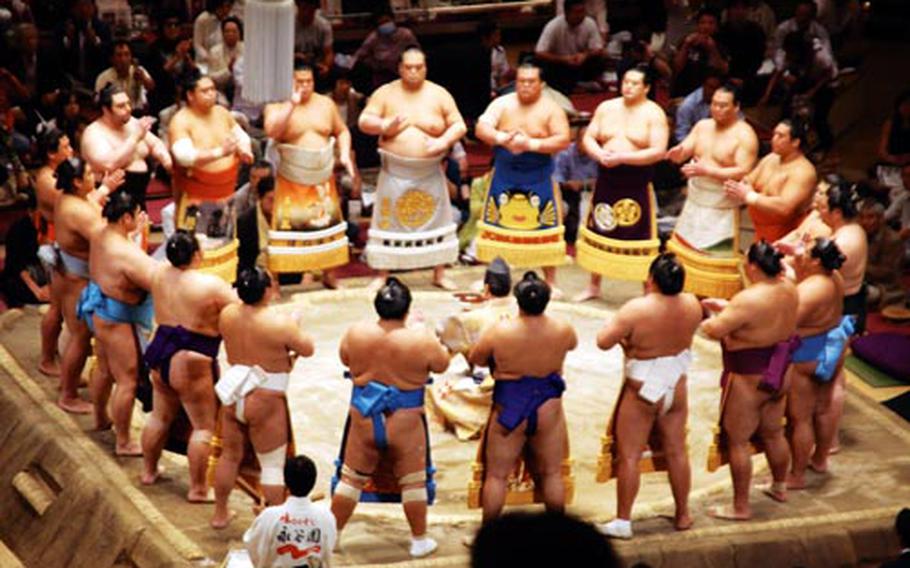
Sumo wrestlers in the senior division step into the ring wearing their intricately designed aprons or “kesho-mawashi” during the makuuchi wrestlers ceremonial entrance at the Ryogoku Kokugikan arena in Tokyo on the eighth day of the 15-day tournament — “basho” — on Sept. 20. (Grant Okubo / S&S)
Seeing a sumo tournament live in Japan is a must.
I’d seen a clip or two on television, but watching it on the tube doesn’t do the sport justice.
One might think that anyone can get big and put on a diaper — it’s actually called a "mawashi" — and slap another fat guy around a ring a few times.
However, behind those mounds of jiggling flesh is an amazing display of skill, strength, speed, strategy, culture and tradition.
Entering the Ryogoku Kokugikan arena in Tokyo for the eighth day of a 15-day tournament, or "basho," was quite exciting. Initially, it appears to be like any American sporting venue. Lines of people stand at food and souvenir vendors littered outside the seating areas. The food prices are generally on par with those you’d see at events in the States, so bring a lot of money if you plan on eating like the not-so-svelte sultans of swat you’ve come to see.
Later, while walking up, up, up toward my seat, I realized we wouldn’t have the best view of the match.
The arena has two levels. The first provides a wonderful view of the wrestlers (and for $100 or more, the view better be wonderful). I, however, opted to go with the base tour for this event and shelled out $90 for a ticket and transportation to the event. Actual ticket prices in the upper level begin at $30. You get what you pay for, was my foremost thought as I watched the match from a very steep angle. From that view, the hulking mammoths looked more like munchkins. This resulted in frequent trips down to the lower level in an attempt to get some decent photos of these rotund athletes. I was quickly "encouraged" by ushers to return to my seat on most occasions.
The day’s matches began at 9 a.m., with the younger and less-experienced wrestlers squaring off. For this newcomer, seeing the progression between the levels was quite interesting.
It wasn’t until about 4 p.m. that the upper-level wrestlers went at it. I immediately noticed the vastly-elevated level of skill compared to earlier matches. These top wrestlers are distinctly larger and have more definition in their shape. Their slaps and thrusts even sound like they have that much more oomph behind them upon contact.
I didn’t expect it, but during one match a wrestler’s head began bleeding. Anyone who doubts the veracity of these matches should have seen the strawberry gash on top of his forehead. These guys definitely don’t hold back.
Yet, what had me the most amazed, was the speed of the sumo wrestlers. It was like watching a quick-striking, portly panther pouncing on its prey.
As a sumo first-timer, I appreciated not only the athleticism but also a great deal of ritualism and pageantry embedded in this centuries-old sport. The matches included ceremonial entrances. One might compare these to player introductions in many sports, but held with far greater regard. Even the garments and hair-styles worn by the sumo wrestlers hold special meaning.
My sumo experience ended with the traditional ceremony, where a lower-ranking wrestler enters the ring and performs a bow dance, or yumitori-shiki. This was followed by the beat of a drum, welcoming fans to come back again. Something I definitely plan on doing.
How is the winner determined?
The winner of a sumo match is either the first wrestler to force his opponent to step out of the ring or the first to force his opponent to touch the ground with any part of his body other than the bottom of his feet.
What are the different levels of sumo?
There are six divisions: from highest to lowest they are makuuchi, juryo, makushita, sandanme, jonidan and jonokuchi. In the upper echelon in the makuuchi division, the majority of wrestlers are maegashira and are numbered from one (at the top) down to 15. Above the maegashira are the three champion or titleholder ranks, called the sanyaku. These are komusubi, sekiwake and ozeki. At the pinnacle of the ranking system is the rank of yokozuna, or grand champion.
How large is the ring?
The "dohyo" — as the ring is called — is 4.66 meters in diameter.
Why do the wrestlers throw salt and stomp their feet in the ring before their matches?
Throwing of the salt is an ancient practice, which is believed to have purifying effects. The wrestlers’ stomping motion is made to squash out evil spirits.
When is the best time to catch a sumo match?
"Bashos" take place six times a year, with each lasting two weeks. The last "basho" of the year is Nov. 15-29 at the Fukuoka Kokusai Center in Fukuoka. The basho returns to Ryogoku Kokugikan in Tokyo on Jan. 10-24.
For more information, including tickets and schedules visit www.sumo.or.jp/eng / .